Ghugni is one of the most loved snacks in India– I can safely say that. The sheer simplicity of dried yellow or white peas, cooked with Indian gravy is unparallel. But what sets one state from the other, in the taste of Ghugni (or chana in a few states), is the topping. In Bengal, we use some chopped onion, green chilly and maybe a short sprinkle of tamarind water as the topping for this dish. But, in many places, bhujiya or chopped coconut is very common. Though ghugni is an evening snack mostly, a combination of the same with quartered bread is also seen as a common lunch item or even a breakfast dish here. You can check the video on the same at Aaheli Express below.
Surprisingly, Ghugni is seen as a vegetarian dish, where in reality, in Bengal, the Mangsher Ghugni or Mutton Ghugni is also pretty popular. And this post is dedicated to one such vendor in South Kolkata, who makes a fabulous Mangsher ghugni.
Some gyan on Ghugni
Let me take the liberty of calling Ghugni as a successor of mixed dal. Please don’t kill me, I like to explain things in an over-simplified manner. Now, dal is a staple favorite from the time of Yajurveda, as mentioned by Mr. K.T. Achaya in his book Indian Food: A Historical Companion. even in Markandeya Purana and Vishnu Purana, the mention of chickpea or chana is there. During the Vedic period, kulmasha is used as a poor man’s staple. Even Lord Rama loved a soaked raw dal item called Kosumalli, which was tossed with chopped cucumber and coconut. So, after this heavy dosage of gyan, we can very safely conclude that the fetish for ghugni is not something new … But what about its non-veg variant?
Back to modern times
This gentleman sits with his stall every day in the evening at the crossing of Ruby Hospital Kasba, just adjacent to the Gateway Hotel. And, if you can’t find a good parking spot (which you won’t), you can park your car in the adjacent lane and walk along to this stall. Once you reach the crossing, ask for anyone for the ghugni stall of Ashok Gayen and they’ll guide you. Do check this landmark of auto stand in this picture.
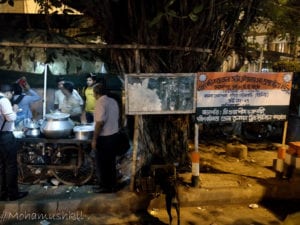
Ashok da sits here from evening 5 every day with his offerings and they’re pretty simple. One vegetarian ghugni, one with mutton keema (or shall we say, mixed with fat and innards), one aloo dum, chicken Kosha and one gila Mete. Now, I understand, that’s not really a very small offering, but the last item apart from ghugni is something special and needs a shout-out. Most of the items here come with a standard topping. Like the north-Indian counterpart, it has chopped onion, green chilies, a dash of tamarind water and some secret spice mix.
You can check the video link here …
And finally the offerings …
Let me talk about the facts and numbers. Every morning, he starts his cooking with around 36 Kg Chana and 36 Kg mutton chhant (keema and innards). the whole stuff comes to 3 large handis which he carries to his selling spot. The amount was given out by him. Around 10 Kg potato is cooked every day and brought. He is not sure of the number of plates that are sold, or he didn’t want to come out with the numbers. But it should be somewhere around 1000 plates of Ghugni.
Being a big-time carnivore, my point of interest was the non-veg Mangsher ghugni. And the taste is simply fabulous. Chewy mutton pieces (who cares which part is it) are cooked along with the yellow peas and finished with the topping. It’s slightly spicy in general. And I prefer it to be a spicier one and chopped chilly is added in a generous amount. Normally, some bhujiya is added, god knows why making it soggy but I prefer to avoid that. I Aloo dum, the Aloo is less fried and mostly, cooked in the gravy, so unlike to my home. And one with simply louuuves it or hate it. The second expression is for me.
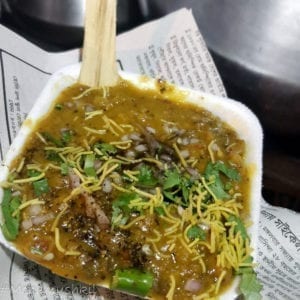
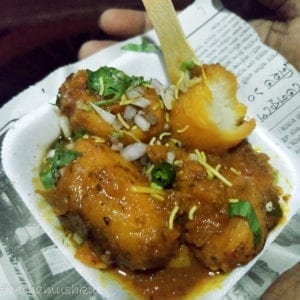
aloo dum
Please be sure to reach the spot by 7 PM , or forget about tasting the chicken Kosha. Small chicken pieces are cooked with a strong flavor of garlic and thus makes it a superb accompaniment for booze. But, even interesting is the item called Gila Mete. It’s the less-edible parts of a whole chicken. Neck, liver, innards etc are cooked with a super-spicy dry masala mix and is loved by many. And the reason primarily is its pocket-friendly price. In fact, I am told that it’s demand is more than the chicken Kosha.
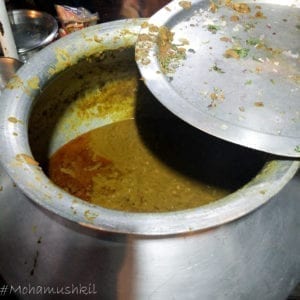
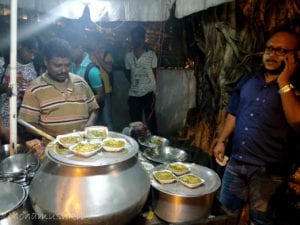
mangsher ghugni stall
The crowd is a typical middle-class mango people, returning from office or college. The Mangsher Ghugni is priced at 10/- a plate and so is Aloo dum. Chicken Kosha is 40/- a plate. Last time I met Ashok da, he happily told that he will be shifting to the permanent stalls across the street. And his face was beaming with happiness.
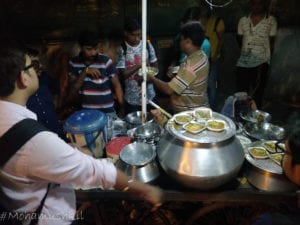
Now, these are few of the street food stalls who, despite the odds, made a name for themselves. And as we know, it’s all that matters. I’d like to thank my Friend Amrita Sarkar for introducing me to this gem. I’d suggest you take the food parcelled from here and he does a neat job with silver foiled packs. But do check the other culinary hidden gems like the sui mai near this place at Pou chong, or if you’re looking for some dessert at a pocket-friendly price, The Gateway is just next door- literally.
update from December 2019
As I told before, the ghugni stall had been shifted from the usual location. So recently, I’ve been there. If you’re going from Ruby signal towards Garia down the E M Bypass, you’ll find many permanent stalls on your left. It’s been shifted there. Please look for the crowd infested stall with a big deg and he’s Ashok da, your man. Due to a change in place, the sales figure is down for him, but do visit him for some kick-ass stuff … Here are the pics.
Do let me know how was your experience at this place, and let my city amaze you for many more such hidden gems.
Bon apetit !!
I can be reached at 9903528225 / indrajit.lahiri@ymail.com

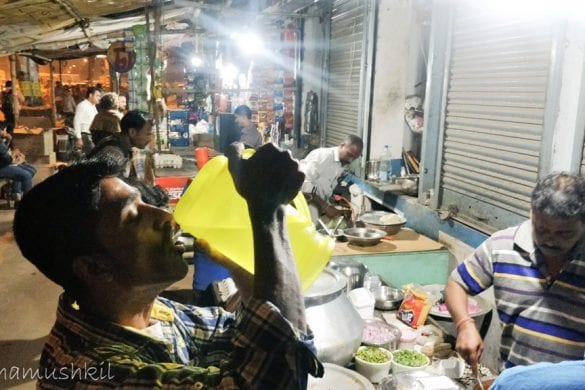
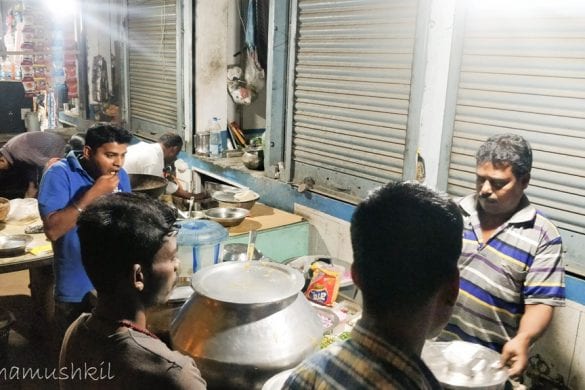
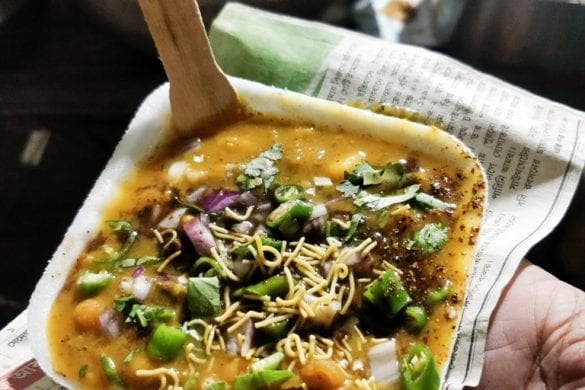
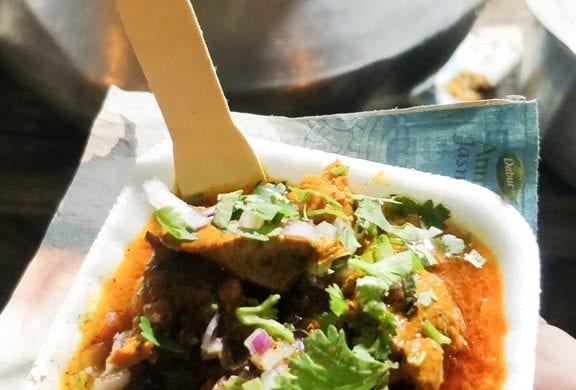
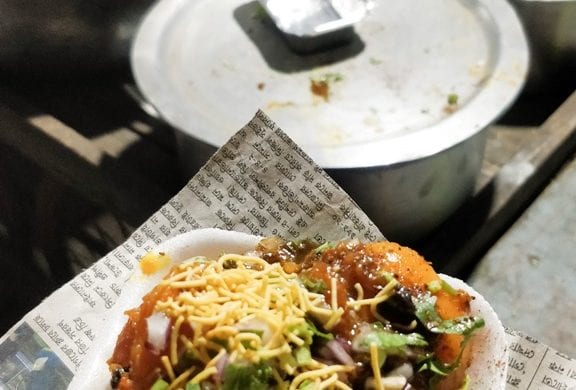
3 comments
Mouth watering recipes.
দারুণ লাগলো পড়ে। পরের বার নিশ্চয়ই যাওয়ার চেষ্টা করবো।
Thanks. But sadly, this gentleman has moved to some other place. I’ll try and locate that soon